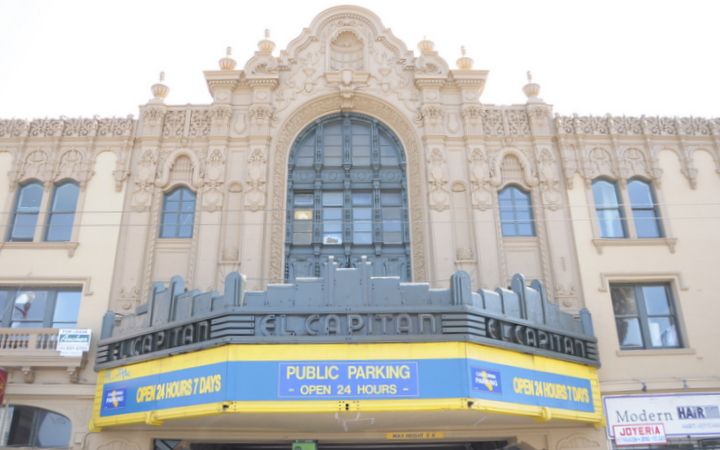The Worst Sewer Overflow Hotspots in NYC
Learn what a recent Supreme Court ruling might mean for the safety and quality of NYC's bodies of water.



Before Netflix, streaming videos and television, most people got their entertainment at a vaudeville/movie theater. These “palaces” were places to see and be seen. The Mission district was the home to at least five theaters whose marquees still can be seen amongst the graffiti and signage that marks the street.
Of these theaters, the El Capitan Theater was the crown jewel. Opened on June 29, 1928, it seated 2578 patrons.
The El Capitan was designed by famed theater designer Gustave Albert Lansburgh. Lansburgh was the principal architect of theaters all along the west coast from 1900 to 1930. The El Capitan was built for a group of businessmen, Ackerman, Harris and Oppen, who managed several San Francisco theaters.
Lansburgh, a graduate of UC Berkeley and a draftsman for Bernard Maybeck, gave the El Capitan a Spanish Colonial Revival interior with a Churrigueresque or Mexican Baroque faà§ade.
Spanish Colonial Revival Architecture was born as a result of the Panama-California Exposition (held in San Diego in 1915), and became a style movement in the United States from 1915 to 1931. It is a hybrid style based on the architecture from the early Spanish colonization of North and South Americas. It started in California and Florida, which had the ideal climate for Mediterranean-inspired homes and remains popular to this day.
The style is usually marked by the use of smooth plaster and stucco walls with cast concrete ornamentation. Other characteristics often include small porches or balconies, tall double-hung windows, canvas awnings, decorative iron, ornamental tile work and arcades.
Churriqueresque, or Mexican Baroque was named after Spanish sculptor and architect Jose Benito de Churriquera. The style emerged in the 17th century and is marked by extremely expressive and florid decoration. It is normally found on the main entrance faà§ade of a building.
Not only was the El Capitan the most opulent of the many Mission Street theaters, it was also the second largest movie theater in town. It was the first to bring second-run films in wide-screen cinema scope to the Mission, and did so until the fall of 1953. (Second run films are often shown in less popular venues after opening in larger well-known theaters; these theaters keep a larger share of the ticket fees and often charge a lower ticket price.)
Sadly decreasing revenue-due to the advent of television-coupled with the large operating costs of such a grand theater, the El Capitan closed on July 24, 1956. The next year it tried for a second life, reopening on May 1, 1957, with reduced prices, but to no avail. The theater was permanently closed before the year was out.

The final indignity to the El Capitan was its gutting in 1964. The grand Churriqueresque entry way now serves as a portal to a large parking lot.

The Wigwam was opened at 2555 Mission Street in 1913 by Joe Bauer. Al Jolson always played here when he was in town. The theater became the New Rialto (1930-1947) then the Crown (1947-1974), and finally ended its life as the Cine Latino when it closed in 1990.

At 2465 Mission Street stands the Majestic Theater. This two-story, 870-seat theater opened in April 1912. A 1937 name change to “The Tower” accompanied a remodel in a Streamline Moderne style by architect S. Charles Lee. Lee was another of the celebrated and prolific theater architects of his generation, and a huge proponent of Streamline Moderne and Art Deco in theater design. The theater closed in 1996.

The Grand (2665 Mission Street) opened in 1940. Designed by Alexander A. Cantin (an Oakland native and one of the first licensed architects in California) and A. MacKenzie Cantin, the Grand showed third-run films to a potential audience of 850 people. The theater closed in 1988.

The New Mission is the last on our tour. The New Mission was designed by the Reid brothers, the greater Bay Area’s most prolific designers of vaudeville and movie theaters. Built in 1915, it had 2000 seats. In 1932, Timothy Pflueger designed a renovated New Mission in an Art Deco Style. The fate of this movie house has remained in limbo since it closed in 1993. Since then, the “Save-New-Mission” preservation group has worked actively to see that the palace does not disappear. Its fate is still unknown as of the publication of this article.
El Capitan Theater [Map]
2353 Mission Street
San Francisco
Follow Untapped Cities on Twitter and Facebook. Get in touch with the author @PQPP3.
Subscribe to our newsletter